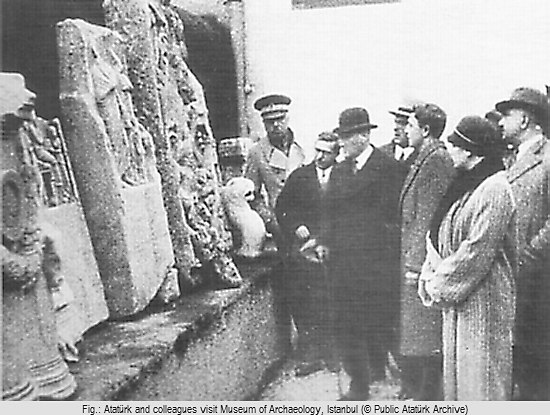For this reason; in the paper presented to International Congress "Archaeology in Conflicts" held in Vienna between (6-10 April 2010) ideas, decisions and applications of Commander and President Atatürk are stated about protection of cultural heritage before, during and after war. As it is known, throughout history, many communities and states accepted depredation of cities they invaded during war as the rule. But as far as noticing that sacremental places or monuments prized by society were being destroyed irrevocably, countless national and international measures had been taken for protection of celestial, historical and cultural properties in war and peace.
The greatest human loss and destruction of cultural properties especially in Europe had been first lived in I. World War. (1914-1919) Mustafa Kemal Atatürk commanded to wars in many front lines especially in Çanakkale (Dardanelles) front line during this war as a military officer of Ottoman State.
With Mondros Armistice, war between Allied Powers and Ottoman State finished, invasion in Turkish lands started and Ottoman State signed up the treaty of Sevres (19 August 1920) . But Turkish Grand National Assembly (TBMM) opened in 23 April 1920 in the leadership of Mustafa Kemal Atatürk annouced to the World that they did not accept this possible treaty. And then, Independence War of Turkish people started and its finished with Lausanne Peace Agreement (24 July 1923) During this period in the stage of history place of Mustafa Kemal was President of TBMM and Chief Commander of Independence War.
When Independence War was going on, by directives of Atatürk, some national activities were being carried out to protect cultural heritage (1919-1923). For instance, in 1921, while war continued 90 km far from Ankara, Ankara Anatolian Civilizations Museum was established and laid the foundations of many museums in different provinces.
After opening TBMM, during Independence War, the decisions of the first government were to take measures establishing new organizational structures and making new arrangements in protection law made by Ottoman State in 1846 for protecting cultural properties in war.
Atatürk became the first president of Turkish Republic founded in 29 October 1923 after the Independence War which was described as "Turkish Miracle" by Western historians.
In the first ten years of new Turkish Republic, which was war weary and had a zeroed economy but looking at the future hopefully, many reforms had been performed for protection of cultural properties. It is underlined that, during these reforms. UNESCO had not been established yet.
Just after the victory, by command of Atatürk and attempts of Museums Director Halil Ethem Eldem 53 chests archaeological findings in Sadr sent to New York Metropolitan Museum by ship from Izmir during the Independence War were sent back to Turkey in June of 1924.
For investigating and protecting all civilizations lived on this land; Turkish Historical Society (TTK) was founded in 15 April 1931.
As from first years of Republic; new universities, archaeology departments were established and 24 new museums were opened. According to directives of Atatürk students were sent to Europe for taking archaeology education. Surface researches, archaeological excavation studies and restorations of historical buildings had been started which were all being followed personally by Atatürk and his senior officials.

In 1935, Atatürk, who adopted protection of cultural heritage as a government policy, gave an order of 10 articles and were put these orders into practise. 10 articles which still keep their importance and actuality in our age included in the importance and necessity of "education, taking enough necessary measures for the collection, protection and restoration of all kind of cultural, architectural and archaeological objects, buildings, making national and international collaboration with expert organizations for scientific researches, local environment, civil societies and media being sensitive, adequate archaeological excavations, for the protection of the cultural heritage".
Before Charter of Athens had not been published yet, which was the first international legislation leading modern urban planing, (1933) according to Atatürk's directives, urban planing studies had been started in company with foreign experts in Ankara, Capital of the Republic (1924).
It is necessary to remind Commander and Stateman Mustafa Kemal Atatürk's decisions, ideas and applications about protection of cultural properties before, during and after war in the light of aphorism, "If lesson was taken from the history, has history repeated?" to today's and future's commanders, civil authorities and decision makers once more. With these decisions and applications, it is understood that Atatürk took into consideration contemporary approaches and applications from the history and took lessons from them during his commandership policy in war and government policy in peace.
No doubt that still today there are lessons that all humankind should take from Atatürk's ideas, decisions and applications for the protection of the cultural heritage.![]() © Saadet Guner, Melek Yildizturan
© Saadet Guner, Melek Yildizturan
e-mail: saadetg@tnn.net
This article should be cited like this: S. Guner, M. Yildizturan, Mustafa Kemal Atatürk and Cultural Heritage: the Experience of Past Wars for Next Generation, Forum Archaeologiae 55/VI/2010 (http://farch.net).